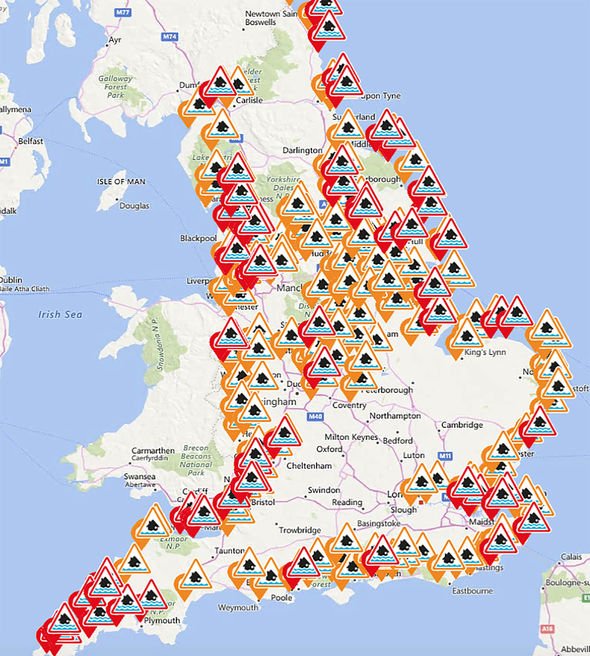Flood Alerts Explained: Understanding Flood Warnings And Staying Safe

Table of Contents
Different Types of Flood Alerts and Warnings
Understanding the nuances between different types of flood alerts is vital for effective response. Failing to distinguish between a flood watch and a flash flood warning could have serious consequences. Let's break down the various alert levels:
Flood Watch
A flood watch indicates that conditions are favorable for flooding within the next few hours or days. It's a preemptive warning, urging residents to monitor conditions and be prepared. Think of it as a yellow light – caution is advised.
- Be aware of rising water levels: Keep an eye on local streams, rivers, and low-lying areas.
- Prepare an emergency kit: Gather essential supplies like water, non-perishable food, medications, and important documents. Having a "go bag" readily available is crucial.
- Monitor local news and weather reports: Stay informed about evolving weather conditions and potential flood threats through radio, television, and official weather websites.
Flood Advisory
A flood advisory means that flooding is occurring or is imminent. While not as urgent as a warning, it signifies that flooding is a real and present danger, requiring immediate attention to protect your property.
- Move valuables to higher ground: Relocate furniture, electronics, and other important belongings to upper floors or higher ground to prevent damage.
- Avoid driving or walking through flood waters: Flood waters can be deceptively deep and swift, and often hide unseen hazards like downed power lines and debris. Turn around, don't drown!
- Be cautious near rivers and streams: Rapidly rising water levels can be dangerous, so stay away from riverbanks and streams during a flood advisory.
Flood Warning
A flood warning signifies that flooding is occurring or is expected to occur imminently. This is a serious alert requiring immediate action to protect yourself and your family. Evacuation may be necessary.
- Evacuate immediately if instructed by authorities: Obey all official evacuation orders promptly. Your life is more important than your property.
- Seek higher ground: Move to a safe location above the flood level, ideally to a designated shelter.
- Do not attempt to drive through flood waters: Flood waters can quickly sweep vehicles away, even seemingly shallow water can be incredibly dangerous.
Flash Flood Warning
This is the most dangerous flood alert, indicating a sudden and rapid flood. Immediate action is crucial to save lives. Response time is critical during a flash flood.
- Seek immediate higher ground: Find the highest point possible as quickly and safely as you can.
- Do not attempt to cross flowing water: Even a seemingly small stream can become a raging torrent during a flash flood.
- Listen for emergency alerts and sirens: Pay close attention to official warnings and instructions.
Understanding Flood Risk in Your Area
Proactive preparation is key to mitigating flood risk. Understanding your specific vulnerability is the first step.
Identifying Flood Prone Zones
Learn about your community's flood history and identify areas at high risk. Understanding your local flood risk is paramount.
- Check FEMA flood maps online: The Federal Emergency Management Agency (FEMA) provides detailed flood maps for most areas.
- Contact your local government for flood risk information: Your city or county may have additional resources and information specific to your community.
- Look for historical flood markers in your area: These markers can indicate areas previously affected by flooding.
Building a Flood Preparedness Plan
Developing a comprehensive family emergency plan is crucial for staying safe during a flood.
- Create a family communication plan: Establish a system for checking in with family members during and after a flood.
- Identify safe evacuation routes: Plan multiple escape routes from your home and know where to go if you need to evacuate.
- Pack an emergency kit with essential supplies: Include water, food, medications, first-aid supplies, flashlights, and important documents.
Safety Measures During a Flood
Knowing how to act during a flood is as important as knowing when to act.
Evacuation Procedures
Knowing your evacuation route and following instructions from emergency officials are critical during a flood.
- Never drive through flooded areas: The depth of water may be deceiving and currents extremely strong. Even a small amount of water can sweep a car away.
- Follow evacuation orders promptly: Don't delay; evacuation orders are issued for your safety.
- Seek shelter in designated safe zones: Utilize designated shelters provided by local authorities.
Protecting Your Property
Before a flood hits, take steps to protect your home and belongings.
- Move valuable items to higher ground: Protect irreplaceable items from water damage.
- Protect electrical appliances from water damage: Disconnect appliances to prevent electrical shock and damage.
- Consider installing flood barriers: Flood barriers can help protect your home from rising waters.
Post-Flood Safety
Be aware of potential hazards after floodwaters recede.
- Beware of downed power lines: Avoid contact with any downed power lines, as they may be live and dangerous.
- Avoid contact with floodwater: Floodwater can be contaminated with sewage and other harmful substances.
- Report damage to your insurance company and local authorities: Document the damage to your property for insurance claims and to help local authorities assess the overall impact.
Conclusion
Staying informed about flood alerts is critical for safety. By understanding the different types of flood warnings—from flood watches to flash flood warnings—and implementing a comprehensive preparedness plan, you can significantly reduce your risk and protect your family and property. Remember to regularly check for flood alerts in your area and be prepared to act quickly. Don't wait for a flood alert to start planning – understanding and preparing for potential flood alerts today will save you peace of mind tomorrow. Create your flood preparedness plan today!

Featured Posts
-
 Heineken Exceeds Revenue Forecasts Maintains Positive Outlook Amid Tariffs
May 25, 2025
Heineken Exceeds Revenue Forecasts Maintains Positive Outlook Amid Tariffs
May 25, 2025 -
 Live M56 Traffic Updates Motorway Closed After Serious Crash
May 25, 2025
Live M56 Traffic Updates Motorway Closed After Serious Crash
May 25, 2025 -
 Eurovision Village 2025 Conchita Wurst Live With Special Guest Jj
May 25, 2025
Eurovision Village 2025 Conchita Wurst Live With Special Guest Jj
May 25, 2025 -
 The Philips Future Health Index 2025 How Ai Will Reshape Global Healthcare
May 25, 2025
The Philips Future Health Index 2025 How Ai Will Reshape Global Healthcare
May 25, 2025 -
 Lauryn Goodman And Kyle Walker Unpacking The Italian Relocation
May 25, 2025
Lauryn Goodman And Kyle Walker Unpacking The Italian Relocation
May 25, 2025
Latest Posts
-
 Real Madrid E Bueyuek Darbe Doert Oyuncu Sorusturma Altinda
May 25, 2025
Real Madrid E Bueyuek Darbe Doert Oyuncu Sorusturma Altinda
May 25, 2025 -
 Queen Wens Parisian Return A Courtly Affair
May 25, 2025
Queen Wens Parisian Return A Courtly Affair
May 25, 2025 -
 Zheng Qinwen Upsets Sabalenka In Rome Sets Up Gauff Clash
May 25, 2025
Zheng Qinwen Upsets Sabalenka In Rome Sets Up Gauff Clash
May 25, 2025 -
 Atletico Madrid Espanyol Maci Hakemin Tartismali Kararlari Ve Takla
May 25, 2025
Atletico Madrid Espanyol Maci Hakemin Tartismali Kararlari Ve Takla
May 25, 2025 -
 O Kuluebuen Basina Bueyuek Bela Doert Oyuncuya Sorusturma Acildi
May 25, 2025
O Kuluebuen Basina Bueyuek Bela Doert Oyuncuya Sorusturma Acildi
May 25, 2025
